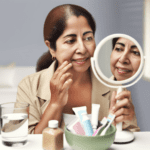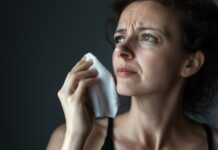Menopause and Pelvic Health
Menopause is a natural biological process that marks the end of a woman’s reproductive years. Typically occurring between the ages of 45 and 55, menopause is defined by the cessation of menstrual periods for one continuous year. The transition to menopause, known as perimenopause, involves significant hormonal changes, particularly in estrogen and progesterone levels, leading to a variety of symptoms that can affect a woman’s quality of life.
The Overlooked Pelvic Symptoms
While many are aware of common menopausal symptoms such as hot flashes and mood swings, pelvic health symptoms are often less discussed. These include urinary incontinence, vaginal dryness and irritation, recurrent urinary and vaginal infections, chronic pelvic pain, and pelvic organ prolapse. These symptoms can cause significant discomfort and impact daily activities, yet they are frequently overlooked or not attributed to menopause.
Prevalence and Significance of Pelvic Symptoms
Over 50% of women experience pelvic symptoms during menopause, which can lead to distress and anxiety. The decline in estrogen levels around the genital region is a primary cause, leading to thinning tissues, increased inflammation, and changes in vaginal pH. These changes can result in a range of issues from pain during intercourse to an increased risk of infections. Despite their prevalence, these symptoms are often underreported due to discomfort discussing them or lack of awareness of their connection to menopause. Recognizing and addressing these symptoms is crucial for improving the overall well-being of menopausal women.
Common Pelvic Symptoms of Menopause
Urinary Incontinence: Types and Triggers
Urinary incontinence is a prevalent pelvic symptom during menopause, affecting many women’s quality of life. There are two primary types: urge incontinence, which is the sudden, intense urge to urinate leading to involuntary leakage, and stress incontinence, where coughing, laughing, sneezing, or physical activity like jumping causes leakage. These symptoms are often due to the weakening of the pelvic floor muscles and the reduction in estrogen, which affects the health and function of the urethra and bladder.
Vaginal Dryness and Irritation
As estrogen levels decline, many women experience vaginal dryness and irritation. This can lead to discomfort, particularly during sexual intercourse, and contribute to feelings of soreness or itching around the vulva and urethra. The lack of estrogen makes the vulvovaginal tissues thinner and less elastic, akin to a garden deprived of water, leading to increased sensitivity and potential inflammation.
Recurrent Urinary and Vaginal Infections
Menopause can also lead to an uptick in urinary and vaginal infections, such as thrush and bacterial vaginosis. The change in vaginal pH due to decreased estrogen levels creates an environment more susceptible to infections. These infections can be particularly troublesome as they may not always be detected through standard tests, leading to prolonged discomfort without proper treatment.
Chronic Pelvic Pain
Chronic pelvic pain is a complex symptom that can manifest in various ways, including pain during intercourse, urination, or even at rest. It can be due to multiple factors, such as organ-related issues, muscle-related causes, or psychosocial components. The pain may be a result of conditions like fibroids, scar tissue, or muscle disorders, and it’s essential to consult a healthcare provider to determine the underlying cause and appropriate treatment.
Pelvic Organ Prolapse
Pelvic organ prolapse occurs when the pelvic organs, such as the bladder, uterus, or rectum, descend due to weakened pelvic floor muscles and reduced estrogen levels. Symptoms include a sensation of heaviness or bulging in the vaginal area, which can be exacerbated by activities like straining during bowel movements. This condition can significantly impact a woman’s comfort and quality of life.
Understanding these symptoms is crucial for seeking appropriate treatment and relief. While they are common, they are not an inevitable part of aging, and various interventions can help manage and alleviate these unwelcome changes.
Biological Mechanisms Behind Pelvic Symptoms
Role of Oestrogen in Pelvic Health
Estrogen plays a pivotal role in maintaining the health and function of the pelvic region. It influences the integrity of the urogenital tissues, including the urethra, bladder, and vaginal walls. Estrogen receptors are abundant in the pelvic area, and the decline in estrogen levels during menopause can lead to thinning and weakening of these tissues. This hormonal change can result in a range of pelvic symptoms, such as urinary incontinence, vaginal dryness, and pelvic organ prolapse. The loss of estrogen’s protective effects makes the pelvic tissues more susceptible to inflammation and irritation, often leading to discomfort and increased risk of infections.
Changes in Vaginal pH and Their Effects
The acidic environment of the vagina is crucial for preventing the overgrowth of pathogenic bacteria and maintaining a healthy balance of the vaginal microbiome. Estrogen influences the production of lactic acid by vaginal lactobacilli, which helps to maintain an optimal pH level. As estrogen levels drop during menopause, the vaginal pH becomes more alkaline, disrupting the microbial balance. This shift can lead to an increased risk of vaginal infections, such as bacterial vaginosis and urinary tract infections, as the protective lactobacilli are outnumbered by harmful bacteria.
Muscle Mass Reduction and Pelvic Floor Weakness
Estrogen also affects muscle mass and strength, including the muscles of the pelvic floor. These muscles support the bladder, uterus, and other pelvic organs, and their weakening can lead to conditions like pelvic organ prolapse and stress urinary incontinence. Menopause is associated with a natural decline in muscle mass, and the pelvic floor is not exempt from this process. The reduction in muscle mass, compounded by the loss of estrogen’s supportive role, can result in a weakened pelvic floor, making it more challenging to maintain continence and organ support.
Understanding these biological mechanisms is essential for developing effective interventions to manage and alleviate pelvic symptoms associated with menopause. By addressing the underlying causes, such as hormonal imbalances and muscle weakness, healthcare providers can offer targeted treatments that improve pelvic health and quality of life for menopausal women.

Managing Pelvic Symptoms: Medical Interventions
Topical Oestrogen and Hormone Replacement Therapy
As women transition into menopause, the decrease in oestrogen levels can lead to a variety of pelvic symptoms, including vaginal dryness, irritation, and urinary incontinence. One effective medical intervention for managing these symptoms is the use of topical oestrogen. This treatment involves the application of oestrogen directly to the vulvovaginal area, which can help improve tissue elasticity and health. Women may notice a reduction in irritation and a decrease in urinary tract infections as the tissues become more robust. However, it’s important to note that the benefits of topical oestrogen may take up to six weeks to manifest.
In addition to topical treatments, Hormone Replacement Therapy (HRT) can be considered. HRT aims to replenish the body’s oestrogen levels, potentially alleviating a broader range of menopausal symptoms. It’s crucial to discuss the various forms of HRT with a healthcare provider, as they can help determine the most suitable option based on individual health profiles and symptom severity.
The Use of Vaginal Lubricants and Moisturizers
Another common and distressing symptom of menopause is vaginal dryness, which can lead to discomfort during daily activities and sexual intercourse. To combat this, many women turn to vaginal lubricants and moisturizers. These over-the-counter products can provide immediate, short-term relief from vulvovaginal discomfort and improve comfort during sex.
When selecting a product, it is important to choose chemical free, water free products, as they tend to provide longer-lasting moisture and are less likely to cause irritation. The leading products here are Mae by damiva and Cleo by damiva. For ongoing relief, chemical free vaginal moisturisers can be used regularly. These products help maintain vaginal moisture and ensure a healthy vaginal environment by keeping the pH low. It’s essential to use only water-free products because only water-free products can be chemical-free. Chemical preservatives are found to disturb the hormone system, can irritate the skin, affect the immune system, and have other negative health effects. Avoid produces with potential irritants like perfumes, alcohol, and water-based substances.
Regular use of chemical-free, water-free products like the ones by Damiva can significantly improve vaginal health and reduce the discomfort associated with menopausal changes.
Ultimately, managing pelvic symptoms during menopause is a multifaceted approach that may include medical interventions like topical oestrogen, HRT, and the use of vaginal lubricants and moisturisers. It’s vital for women to have open discussions with their healthcare providers to find the most effective and safe solutions for their individual needs.

THEN IT CONTAINS TOXIC CHEMICALS. WHY RISK IT GETTING SICK? GO CHEMICAL FREE.
Lifestyle Adjustments for Pelvic Symptom Relief
Reducing Irritation Through Skincare and Hygiene
Menopause can bring about a host of changes in skin condition, including increased dryness and sensitivity. This can particularly affect the delicate skin of the pelvic area. To combat irritation, it is essential to adopt a gentle skincare routine. Non-soap cleansers and fragrance-free products are recommended to minimize the risk of irritation. Additionally, wearing breathable, cotton underwear can help maintain a healthy environment, reducing the risk of infections and discomfort.
Hygiene practices should be balanced – over-washing can strip away natural oils, exacerbating dryness, while insufficient hygiene can lead to infections. It’s important to rinse the area with warm water and gently pat dry. For those experiencing urinary incontinence, changing protective pads regularly is crucial to prevent irritation and odor.
The Impact of Smoking on Pelvic Health
Smoking has a detrimental effect on overall health, and pelvic health is no exception. Nicotine and other chemicals in cigarettes can reduce blood flow to the pelvic region, impairing tissue health and healing. Smoking also increases the risk of urinary incontinence and pelvic organ prolapse due to the coughing fits it can provoke, which put pressure on the pelvic floor muscles. Quitting smoking is a significant step towards improving pelvic health and alleviating menopausal symptoms. Support and resources are available for those looking to quit, including counseling, nicotine replacement therapies, and prescription medications.
Importance of Pelvic Floor Muscle Exercises
The pelvic floor muscles support the bladder, bowel, and uterus. During menopause, these muscles can weaken, leading to symptoms such as incontinence and pelvic organ prolapse. Pelvic floor muscle exercises, commonly known as Kegel exercises, can strengthen these muscles, providing better support for the pelvic organs and improving symptoms.
To perform Kegel exercises, one must first identify the correct muscles, which can be done by trying to stop the flow of urine midstream. Once identified, these muscles should be contracted for three seconds, then relaxed for three seconds, with the aim of doing three sets of ten repetitions daily. It’s important to breathe normally during the exercises and to avoid tensing the abdominal, thigh, or buttock muscles. Consistency is key, and results may take several weeks to notice. For personalized guidance, consulting a physiotherapist specialized in pelvic health can be beneficial.
By incorporating these lifestyle adjustments, women can experience significant relief from pelvic symptoms associated with menopause. While these strategies can be implemented independently, it’s always advisable to seek professional advice for personalized care and to address any concerns.
Holistic Approaches and Alternative Therapies
Exercise Regimens: Yoga and Pilates
For many women undergoing menopause, exercise can be a powerful tool in managing pelvic health symptoms. Yoga and Pilates are two regimens that not only enhance physical fitness but also promote pelvic floor strength and flexibility. Yoga, with its emphasis on mindful breathing and gentle stretching, can alleviate stress and improve the body’s hormonal balance. Poses such as the Bridge or Child’s Pose can be particularly beneficial for strengthening the pelvic area. Pilates, on the other hand, focuses on core strength, which includes the pelvic floor muscles. Engaging in a regular Pilates routine can help in maintaining pelvic stability and preventing prolapse or incontinence.
Dietary Considerations and Supplements
Adjusting one’s diet can also play a significant role in managing menopausal symptoms. Foods rich in phytoestrogens—such as soy products, flaxseeds, and certain nuts—may help to mitigate estrogen loss. Additionally, maintaining adequate levels of vitamins D and B, magnesium, and calcium can support bone health and reduce the risk of osteoporosis. It’s also important to stay hydrated, as water can help maintain the health of the urinary tract and reduce irritation. Supplements should be considered under the guidance of a healthcare professional to ensure they are appropriate for your individual health needs.
Stress Management and Emotional Well-being
Menopause can be a stressful time, and stress can exacerbate pelvic symptoms. Techniques for stress management are therefore crucial. Mindfulness meditation, deep breathing exercises, and progressive muscle relaxation can all help to reduce stress levels. Additionally, engaging in activities that bring joy and relaxation, such as reading, gardening, or listening to music, can improve emotional well-being. It’s also beneficial to connect with supportive communities, such as The Menopause Consortium on Facebook, which can provide a sense of belonging and shared experience during this transition.
Overall, a holistic approach to managing menopausal symptoms involves a combination of physical activity, dietary adjustments, and stress reduction techniques. By incorporating these strategies into daily life, women can gain control over their pelvic health and improve their quality of life during menopause.
Seeking Professional Help and Support
When to Consult a Pelvic Health Specialist
Menopause can bring about a variety of pelvic health issues, some of which may significantly impact your quality of life. It is important to recognize when these symptoms are beyond the scope of self-care and require professional intervention. You should consider consulting a pelvic health specialist if you experience:
- Persistent urinary incontinence that affects daily activities
- Recurrent urinary tract or vaginal infections
- Chronic pelvic pain not alleviated by over-the-counter medication
- Signs of pelvic organ prolapse, such as a feeling of heaviness or bulging in the vaginal area
- Vaginal dryness or irritation that interferes with your sex life or causes discomfort
A pelvic health specialist can provide a comprehensive evaluation and tailor a treatment plan to your specific needs, which may include physical therapy, medication, or even surgery in some cases.
The Role of Mental Health Support
The transition into menopause can be as much an emotional journey as a physical one. The role of mental health support during this time cannot be overstated. Feelings of anxiety, depression, or loss of identity are not uncommon and can be just as debilitating as the physical symptoms. It is crucial to:
- Recognize when these feelings are more than just occasional blues
- Seek support from a mental health professional if you experience persistent sadness, anxiety, or mood swings
- Consider joining support groups where you can share experiences and coping strategies with others going through similar challenges
Therapy, whether individual or group, can provide valuable tools for managing stress, improving emotional well-being, and navigating the changes that menopause brings.
Community and Online Resources
In addition to professional help, there are numerous community and online resources available to women experiencing menopausal symptoms. These resources can offer:
- Educational materials to better understand the changes happening in your body
- Forums and discussion groups for peer support and advice
- Access to local workshops, seminars, and health clinics specializing in menopausal care
- Information on the latest research and treatment options
Online platforms can be particularly helpful for those who may not have easy access to in-person support networks. Websites such as the North American Menopause Society (NAMS) and WomensHealth.gov provide a wealth of information and can guide you to additional resources, including downloadable leaflets and directories of healthcare providers specializing in menopausal health.
Remember, seeking help is a sign of strength, not weakness. By taking advantage of professional support and the wealth of resources available, you can navigate menopause with greater ease and confidence.





















